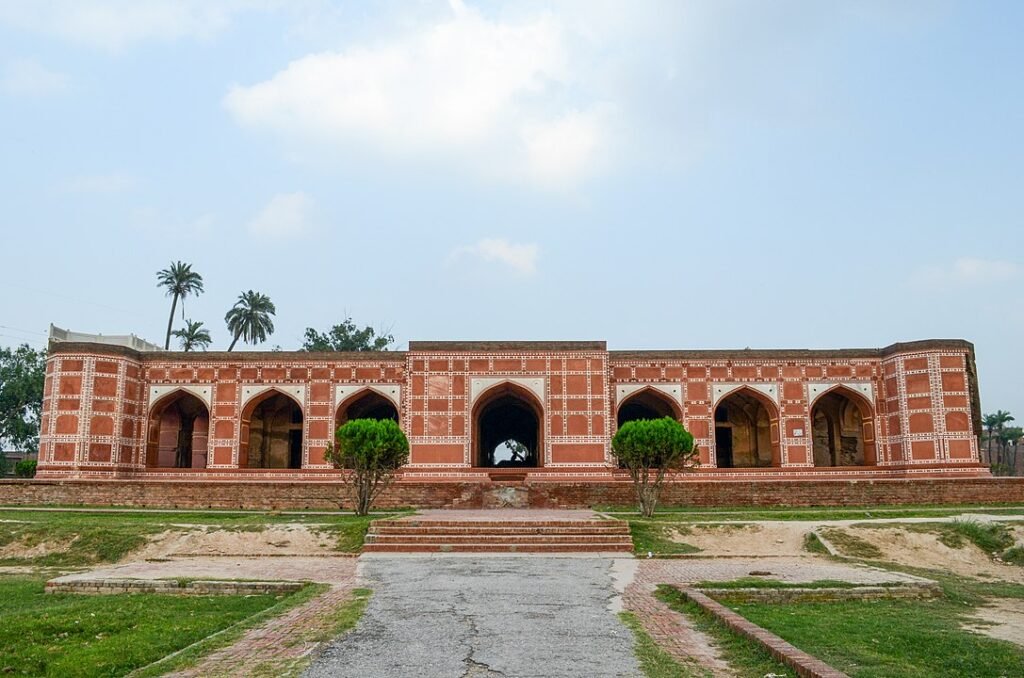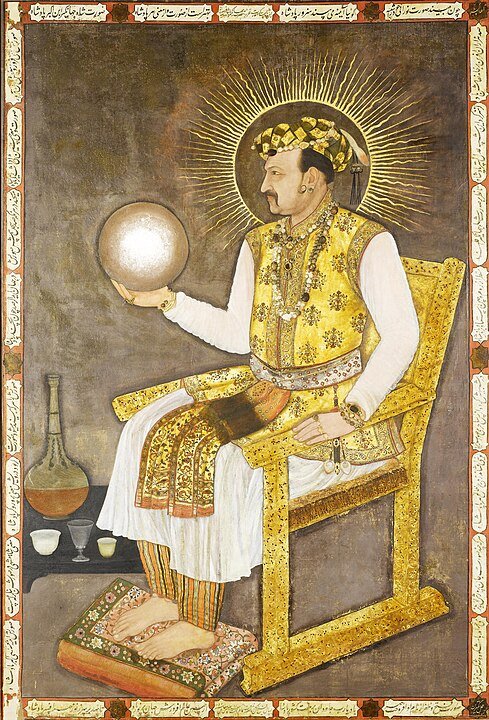Akbar was succeeded by his son Salim with the title Nur-ud-din Jahangir. He was Akbar’s
son by a Rajput wife. His ascension was challenged by his eldest son Prince Khusrau who
staged a revolt with the blessings of Sikh Guru Arjun Dev. Prince Khusrau was defeated,
captured, and blinded, while Guru Arjun Dev was executed. In 1608 Ahmad Nagar in the
Deccan had declared independence under Malik Ambar. During the reign of Jahangir,
there was no addition to the Mughal territory in Deccan.
Jahangir’s reign witnessed the visit of two Englishmen – William Hawkins and Sir Tomas Roe. While the William Hawkins could not get the consent of the Emperor for establishing an English factory in India. Sir Tomas Roe sent as ambassador by King James I, succeeded in securing permission to establish a British factory at Surat. In 1611, Jahangir married Mehrunnisa who was known as Nur Jahan (Light of World). Nur Jahan dominated the royal household and set new fashions based on Persian traditions. She encouraged Persian art and culture in the court. Nur Jahan became the real power behind the throne.
His Administrative Policy, his 12 edicts. This was the basis of the Jahangiri policy. This is
called “Ain-e-Jahangiri”.
12 Famous Administrative Orders of Jahangir
- He abolished the ‘Tamgha’ and ‘meerwahi’ toll taxes and the taxes that the subedars
or governors imposed on the people for their expenses. - He ordered the construction of mosques, series, and wells on the roadsides which
reduced the danger from thieves and dacoits. - He ordered that the property of the dead would be passed over to their legal heirs
and the unclaimed property would go to the state, the income of which would be
spent on public welfare. - He forbade the manufacture and sale of wine and intoxicants drugs.
- He abolished the punishment of cutting off the nose and ears of the accused.
- He ordered that the landlords would not forcibly occupy the lands of the farmers.
- He ordered the construction of a government hospital.
- Animal slaughter was banned for two days a week. Thursday, his coronation day, and
Sunday, and on certain other occasions in the year. - No government collector or Jagirdar could intermarry with the people of his Pargana
without royal permission. - He reinstated all the mansabdars appointed during Akbar’s reign and promoted them
on merit. - All the convicts, serving for longer periods, were released from the jails.
- Madad-e-mash lands were to be confirmed throughout the empire.
The administrative policy of Jahangir
A rajput policy of Akbar continued during this period, No change. He passed his 12 ordinances. He continued the administrative structure of Akbar. He started Du-aspa and Si -Aspa systems. Jaat’s rank will be the same, status same, and responsibility more. A new type
of Jagir called Al Tamgha. Jahangir’s success in the treaty with Mewar Amar Singh. His
biggest achievement was his peace with Mewar.
The religious policy of Jahangir
Akbar religious policy continued. He also believed in the unity of God like Akbar. He also visited Sufi Dargahs many times. He was also a great admirer of the Hindu saint Jadrup Gossai. He appointed many Hindus to a higher posts. He also celebrated Rakshabandan (rakhi). He was also in contact with Krishnan’s missionary. Many European visitors to his court.
Some Controversial actions of Jahangir
He punished Hindus of Rajauri Kashmir. Only because of he married Muslim girls. He celebrated the victory of Kangra (Himachal pradesh) by killing a cow. In Ajmer, he threw away the images of the god temple of Varaha. He punished the Sikh guru. He expelled many Jaina Sant from Gujrat. This is controversial action for many historians. He even punished sheikh ahamad Sirhindi. It is not easy to form an assessment of Jahangir’s religious view.
Role of Nur-Jahan
Nur Jahan (1575-1645), born Mihr-un-Nisa, was the daughter of Persia’s noble family, Mirza Ghiyas Beg. He fled to India in pursuit of fortune after experiencing bad luck at home. When he landed in Qandahar, his wife gave birth to a daughter who later became Emperor Jahangir’s most beloved queen, Nur Jahan.
He was able to obtain job during Akbar’s reign thanks to the help of a friend. He achieved success in court due to his exceptional ability. Mehr-un-Nissa was the second daughter and fourth child of Persian aristocrat Mirza Ghiyas Beg and wife Asmat Begum. Nur Jahan’s parents were both descended from noble families – Ghiyas Beg from Muhammad
Sharif and Asmat Begum from the Aqa Mulla clan.
Mehr-un-nissa married the emperor Jahangir in 1611, which many interpreted as a symbol of love and affection. Historians believe Jahangir intended to marry her before her marriage to Sher Afghan. However, Akbar opposed the match and arranged for her to marry her first husband. Jahangir adored his wedded wife, naming her Nur Mahal (light of the palace) at their wedding and later Nur Jahan (light of the globe). Nur Jahan quickly established control over the realm after her marriage. Because of Jahangir’s love of drinking and opium, as well as his disinterest in administration, the Empress was made responsible for administration and ruling, which Nur Jahan did without hesitation.
She was no stranger to the power of the monarch, having family members in the administration. Her efficiency in the imperial realm established her worthiness for leadership. During her reign, the Mughal Empire experienced unprecedented peace and prosperity. Nur Jahan’s accomplishments as Empress are well chronicled. She made a conscious decision to leave her mark on history. For instance, she was referred to as ‘Nur Jahan, Queen Begum’ in all letters and grants addressed to the emperor, and coins bearing her name were introduced.
Nur Jahan was deeply concerned about the welfare of women, especially orphaned daughters in her reign. She held informal courts to address concerns and make decisions on requests from court nobility. She consolidated the empire’s influence by appointing her father and brother to court positions, as well as marrying Jahangir’s sons from previous spouses through her daughter Laadli and niece Mumtaz Mahal. Despite giving her family power and ensuring the Mughal Empire’s succession, she prioritized the empire’s sanctity.

Nur Jahan traded with European merchants and collected taxes from them. She engaged in international diplomacy with women from other countries. Nur Jahan asserted herself in public, gaining influence through her address rather than her husband’s weaknesses. Nur Jahan recognized the limitations of her power and used innovative methods to ensure the empire’s integrity was maintained. She was noted for her military acumen, which she utilized to successfully deal with several rebel movements.
When Emperor Jahangir was captured by rebel leader Mahabat Khan, Nur Jahan commanded the army to recover him. She signed all of the king’s orders. She makes all key decisions. Jahangir discusses or remarks on it in TUJUK-EJAHNGIRI. Jahangir mentioned that I sold my kingdom to my queen for a cup of wine. Nur jahan is an influential figure during the Jahangir period. Some historians, including Nurul Hassan, argue that she did not initially interfere with governance. She added that she played a vital role due to Jahangir’s declining health.
- Nur Jahan would often appear in the Jharokha, a balcony-like structure.
- She issued official orders in her name and had coins minted with her name, including Dam and Dirham (copper coins) and Rupiya (silver coins).
- Her official title was “Badshah Begum,” and she played a pivotal role in appointing her favored officials.
- She successfully secured the appointment of her father, Ghiya Beg, as Wazir, and maintained her brother’s position as Mir Bakshi.
- Nur Jahan formed a close-knit group of favorites known as the “Nur Jahan Junta” which wielded significant power in the Mughal court by 1620.
- Tensions between Nur Jahan and Prince Khurram (later Shah Jahan) arose when she arranged the marriage of her daughter Ladli Begum to Prince Shaharyan, resulting in Prince Khurram’s transfer to Deccan.
- In 1621, Jahangir fell ill, and the death of Nur Jahan’s father, Itimad-ud-Daula, marked a period of six to seven years filled with conspiracies and revolts in the Mughal court and politics.
- After Itimad-ud-Daula‘s passing, he was laid to rest in Agra, and his tomb introduced the art of Pitra-dura to Mughal architecture.
Conspiracy and Revolt
- In 1622, Khurram initiated a revolt that was later quelled by Mahabat Khan.
- Subsequently, Jahangir pardoned Khurram for his rebellion.
- At a later point, Mahabat Khan himself revolted, primarily due to his close association with Mughal Prince Parwez. This association did not sit well with Nur Jahan, leading to Mahabat Khan’s transfer to Bengal, along with some of his relatives facing humiliation at the Mughal court.
- In 1627, Jahangir passed away, and his tomb is located in Lahore. In 1645, Nur Jahan also departed this world.
Mughal Painting under Jahangir
- The pinnacle of Mughal painting was achieved during Jahangir’s reign.
- Abul Hasan and Bisan Das were renowned for their expertise in portrait painting, while Ustad Mausur gained fame for his depictions of flowers, birds, and animals in his artwork.
- Jahangir initiated a novel tradition by engraving the king’s image onto coins.
Pre & Mains : Buy History NCERT 11th class by R.S.Sharma for UPSC
History Optional : Buy A History of Ancient And Early Medieval India : From the Stone Age to the 12th Century By Upinder Singh
Feature Image Credit and License :- Flickr license
Inline Image Credit and License :- Wikimedia Commons license
